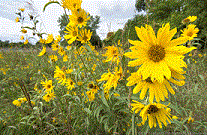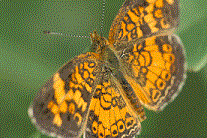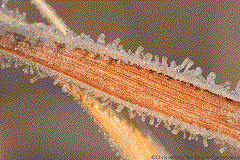Chris Helzer, The Nature Conservancy’s Director of Science in Nebraska talked about the Square Meter Photography Project which took place around Aurora, NE. Chris showed us many photos that he took of animals, flowers and the prairie.
First Chris asked everyone what came to mind when you say "Prairie." I am sure that some of us would think wild flowers, very distinctive birds, bison, etc. Some think flat fields of grass or grasslands.
 Chris’ initial motivation for this project was to draw awareness and appreciation to prairie communities. Prairies suffer from a massive lack of attention and respect from the general public, and that provides a major handicap to those of us advocating for their conservation. That disinterest is true even in a state like Nebraska, where about half of the state is still grassland – including the spectacular Nebraska Sandhills – and where almost no one lives more than an hour’s drive from a prairie. As you can see from the photo on the left, Maximilian sunflowers dominated the square meter of prairie during late August and early September.
Chris’ initial motivation for this project was to draw awareness and appreciation to prairie communities. Prairies suffer from a massive lack of attention and respect from the general public, and that provides a major handicap to those of us advocating for their conservation. That disinterest is true even in a state like Nebraska, where about half of the state is still grassland – including the spectacular Nebraska Sandhills – and where almost no one lives more than an hour’s drive from a prairie. As you can see from the photo on the left, Maximilian sunflowers dominated the square meter of prairie during late August and early September.While he primarily started the project as a way to help others discover prairies and their beauty, the journey has also affected me personally, in ways he hadn’t fully anticipated. Chris has always been drawn to photograph flowers, bugs, and other tiny creatures, but he usually did so while wandering broadly through prairies, looking for subjects that draw his attention. Despite more than 25 years of studying and exploring prairies, forcing himself to sit down and really focus his eyes and camera within a tiny square space has been truly inspirational.
He honestly don’t think he ever visited his plot without seeing something he hadn’t seen there before. The number of species he found was astounding, even as someone who studies and touts the diversity of prairies. He could put together an impressive photo portfolio consisting only of the various fly species of flies he photographed. He also became engrossed by the growth and survival of individual plants, and felt emotionally affected when all four stiff sunflower blossoms in his plot were attacked by swarms of tiny beetles as soon as they opened. Most of all, the rhythms and patterns of prairie life became more apparent to him than they ever had been before. He became intently aware of what was blooming, what was about to bloom, which tiny creatures had newly emerged on the scene, and who was eating whom as a result.
Apart from the impressive biological diversity he observed, he was also stirred by how much beauty he discovered within the confines of a square meter of prairie. Chris photographed a lot of flowers from a lot of angles, but he also found himself admiring the graceful downward curve of Maximilian sunflower leaves, the colorful feathery anthers of grasses, and the glowing backlit patterns of leaf veination. The realm of what deserved his attention as a photographer got much bigger, despite working within a tiny area.
Chris was already knowledgeable and passionate about prairies before starting this project, but he was still deeply moved and inspired by what he found within a single square meter. Far from the drab patches of grass many people imagine them to be, prairies are vibrant and dynamic ecological communities, consisting of complex webs of interacting organisms. There is abundant beauty in prairies, and while you might have to look closely to see some aspects of it, you also don’t have to go far to find it. Chris hopes this project helps inspire people to explore prairies near them, and to help ensure that prairie ecosystems remain diverse and healthy well into the future.
By the end of the year-long project, Chris had photographed 113 different species of plants and animals within this little square meter plot. That includes 15 plant species, 22 different flies, 18 beetles, and 14 bees.
There is a video that includes about 150 of his favorite photos from the project, set to music. You just need to go to: https://prairieecologist.com/square-meter-photograpy-project/ to see the many photos Chris has taken in this project.
Here are a few more photos that he took with this project.
A leaf beetle on lead plant
Chinese praying mantis  Frost on Indiangrass
Frost on Indiangrass


